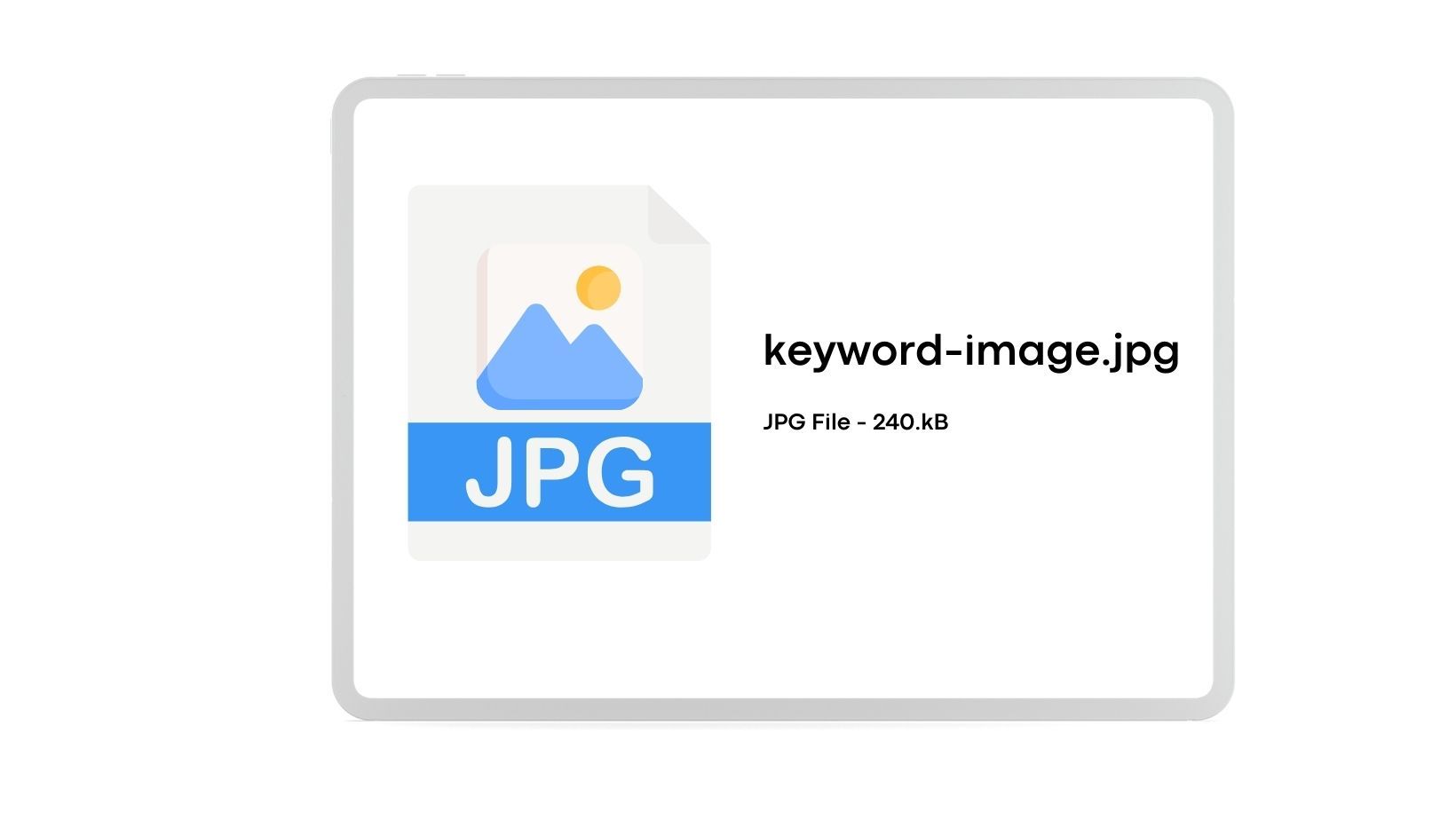
In the realm of search engine optimization (SEO), naming your images strategically can significantly impact your online visibility. Understanding the importance of image SEO and why Google places emphasis on filenames is crucial for anyone looking to enhance their website's search performance. When it comes to SEO, images play a pivotal role in enhancing user experience and conveying valuable information. Optimizing your images for search engines not only improves your website's visibility but also contributes to a more comprehensive and user-friendly online presence.
With the ever-increasing reliance on visual content, search engines like Google are placing greater emphasis on how images are named and tagged. Google's algorithm is designed to interpret and understand the content of an image through its filename.
A well-structured and descriptive filename provides valuable context, helping search engines index and rank your images accurately. Google aims to deliver the most relevant and user-friendly results, and filenames that align with the image's content contribute to achieving this goal. Now, let's delve into the best practices for naming images to maximize their impact on SEO.
Image Filename SEO: The Basics
When it comes to optimizing images for SEO, understanding the fundamentals of image filenames is essential. This section will delve into the core aspects, from defining what an image filename is to exploring the key principles of SEO tailored for filenames.

a. What is an Image Filename?
An image filename serves as a critical element in SEO, providing a digital identity to your visual content. Composed of letters, numbers, and sometimes hyphens or underscores, it offers a unique name to each image file. Beyond mere identification, a well-crafted filename plays a crucial role in search engine optimization by offering contextual information about the image content. This aids search engines in accurately interpreting and categorizing visual information, contributing to improved search performance.
b. SEO for Image Filenames
SEO practices extend to every corner of your digital content, and filenames are no exception. Optimizing image filenames involves more than just choosing a name; it's about strategically crafting descriptive, relevant, and keyword-rich identifiers. Search engines, including Google, consider filenames as valuable metadata, influencing the relevance and visibility of your images in search results. A thoughtful approach to image filenames enhances the overall discoverability of your visual content on the web.

c. Using Keywords in Image Filenames
In the realm of SEO, keywords are the linchpin, and incorporating them into image filenames is a powerful strategy. When selecting keywords for image filenames, choose terms that accurately reflect the content of the image and align with the broader theme of your website. Thoughtful keyword usage not only improves search engine indexing but also establishes a connection between your images and the overarching SEO strategy of your website. It's a nuanced practice that, when done right, can significantly boost the visibility of your images in search results.
d. Ideal Length for Image Filenames
While creativity is encouraged in naming your image files, it's important to strike a balance, especially when it comes to length. An ideal image filename should be concise and descriptive, capturing the essence of the image without unnecessary complexity. Avoid overly long filenames that could dilute their effectiveness. Strive for clarity and relevance in a limited character space to ensure that search engines and users alike can easily comprehend and engage with your images. Remember, a well-optimized image filename is not just a label; it's a key component of your SEO strategy.
Also see: Search Engine Optimization (SEO) Starter Guide 2023
Best Practices for Naming Images for SEO
Crafting effective image filenames is a fundamental step in optimizing your website for search engines. Beyond mere labels, filenames play a critical role in enhancing both user experience and the discoverability of your visual content.
Descriptive and Relevant Filenames for Images
Creating descriptive and relevant filenames is the cornerstone of effective image SEO. When naming your images, ensure that the filename accurately reflects the content it represents. This not only aids search engines in understanding the context of the image but also enhances the overall user experience. Choose filenames that provide a clear and concise description, offering valuable information before a user even views the image.

Inclusion of Targeted Keywords in the Image Filename
Strategic use of keywords is a powerful tool in the SEO arsenal, and it extends to your image filenames. Incorporating targeted keywords in your filenames helps align your images with the broader content theme of your website. However, it's essential to strike a balance—ensure that the keywords seamlessly integrate with the natural language of the filename without appearing forced. This practice enhances the discoverability of your images in search engine results.
Avoiding Generic Names and Keyword Stuffing
While keywords are vital, it's equally important to steer clear of generic names and keyword stuffing. Generic filenames provide little context and can hinder search engine understanding.
On the other hand, keyword stuffing, or excessively loading filenames with keywords, can be perceived as spammy by search engines. Finding the middle ground between specificity and natural language is key to creating filenames that resonate with both search algorithms and users.
Importance of Writing Informative Alt Text for Screen Readers
Beyond filenames, providing informative alt text is an often overlooked aspect of image SEO. Alt text serves as a textual description of an image and is crucial for accessibility, especially for users relying on screen readers. Crafting descriptive alt text not only aids those with visual impairments but also contributes to the overall context of your page for search engines.

Balancing Keyword Usage and User Experience
The art of naming images for SEO involves a delicate balance between keyword usage and user experience. While keywords enhance search engine visibility, it's essential to prioritize the overall user experience. User-friendly filenames contribute to a positive browsing experience, making your website more engaging and accessible. Strive for filenames that seamlessly merge SEO optimization with an intuitive and user-centric approach.
Step-by-Step Guide: How to Name Images for SEO
In the realm of search engine optimization (SEO), the process of naming your images plays a crucial role in enhancing your online visibility. Understanding the significance of image SEO and why Google emphasizes filenames is essential for optimizing your website's search performance.
1. Use of Keywords Identified for the Blog
When it comes to naming images for SEO, the linchpin is strategic keyword usage. Select keywords that accurately reflect the content of the image and align with the broader theme of your website. This practice not only improves search engine indexing but also establishes a seamless connection between your images and your overall SEO strategy.

2. Designing for Users and Search Engines
Balancing keyword usage with user experience is an art in itself. While keywords enhance search engine visibility, it's equally important to prioritize a positive user experience. User-friendly filenames contribute to a more engaging and accessible website, enhancing the overall browsing experience.
3. Identifying All SEO-Naming Opportunities
Optimizing image filenames goes beyond merely choosing a name; it involves strategically crafting descriptive, relevant, and keyword-rich identifiers. Search engines, including Google, consider filenames as valuable metadata, influencing the relevance and visibility of your images in search results. Identify every naming opportunity to maximize the impact on SEO.

4. Using URL Keywords in Image URLs
The importance of keywords extends to image URLs. Incorporate relevant keywords into your image URLs to provide search engines with additional context. A well-structured URL enhances the overall SEO strategy, contributing to improved search performance for your visual content.
5. Using Keyword Phrases as Image Alt Attributes
Beyond filenames, crafting informative alt text is crucial for image SEO. Alt text serves as a textual description of an image and is vital for accessibility, especially for users relying on screen readers. Incorporate keyword phrases into your alt attributes to provide both users and search engines with valuable context about your images.

6. Creating Descriptive Image Captions
Descriptive and relevant filenames are the cornerstone of effective image SEO. When naming your images, ensure that the filename accurately reflects the content it represents. This not only aids search engines in understanding the context of the image but also enhances the overall user experience. Choose filenames that provide a clear and concise description, offering valuable information before a user even views the image.
Other Relevant Image SEO Practices
In the ever-evolving landscape of search engine optimization (SEO), mastering the art of naming images is just one aspect. To further enhance your website's search performance, it's essential to delve into other relevant image SEO practices. Understanding these practices can significantly contribute to a comprehensive and effective SEO strategy.

Understanding Image Dimensions for SEO
Beyond naming conventions, the dimensions of your images also play a crucial role in SEO. Optimizing image dimensions ensures faster loading times, which is a key factor in providing a positive user experience. Search engines value websites that prioritize speed and user satisfaction, making image dimensions an integral part of your overall SEO strategy.
Importance of Using Responsive Images
In today's digital landscape, where users access websites on various devices, using responsive images is paramount. Responsive images adapt to different screen sizes, enhancing the overall user experience. Google, in particular, considers mobile-friendliness as a ranking factor, making the use of responsive images a best practice for SEO. Ensuring that your images look and perform well across devices contributes to better search visibility.

Creating Image Sitemaps
In the intricate web of SEO, creating image sitemaps is a strategic move. Image sitemaps provide search engines with additional information about the images on your website, aiding in better indexing. By creating a dedicated map for your images, you enhance their discoverability, ultimately improving your website's overall search performance.
How to Add Structured Data to Images
Structured data is the backbone of effective SEO, and it extends to your images. Adding structured data provides search engines with additional context about your images, allowing for more accurate indexing and presentation in search results. Understanding how to incorporate structured data into your images is a valuable skill that can elevate your SEO efforts. By enriching the information available to search engines, you increase the likelihood of your images appearing in relevant searches.
Conclusion
In closing, naming images for SEO is a nuanced process that goes beyond mere labels; it's a strategic endeavor that directly impacts your website's visibility and user experience. By adhering to the best practices outlined in this guide—crafting descriptive and relevant filenames, incorporating targeted keywords thoughtfully, and steering clear of common pitfalls like generic names and keyword stuffing—you set the stage for improved search engine performance.
Remember, the art of naming images is just one facet of a broader SEO strategy. As highlighted in this guide, additional practices such as understanding image dimensions, employing responsive images, creating image sitemaps, and incorporating structured data further enhance your website's overall discoverability.
In the dynamic realm of SEO, staying abreast of evolving trends and continuously optimizing your visual content ensures a competitive edge. With a well-optimized approach to image naming and a comprehensive understanding of image SEO practices, you're well-equipped to navigate the ever-changing landscape of online search, fostering a more engaging and accessible online presence.
For further reading, you might be interested in the following:

